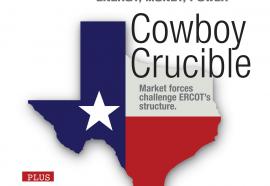Alliant Energy
The Fortnightly 40
The 40 Best Energy Companies
(September 2009) The industry’s best companies are weathering the financial storm reasonably well, with the F40 delivering equity returns in the 14-percent range for fiscal 2008. However, falling sales and rising costs are putting heavy pressure on balance sheets—and on regulatory relationships. Companies that balance customer value and shareholder value will be most likely to thrive in the new normal.
PV's Promise
Chris O’Brien is no starry-eyed idealist. An engineer with an MBA, he began his career developing fossil-fired power plants for the AES Corp. But in the 1990s his career took a different turn, when he launched the Energy Star program for the U.S. Environmental Protection Agency. After that, he went into the solar energy business, and never has looked back.
People (February 2009)
Portland General Electric (PGE) announced Maria M. Pope as senior v.p. of finance, CFO and treasurer. Hawaiian Electric Co. named Richard M. Rosenblum president and CEO. UniSource Energy named Paul J. Bonavia as its chairman, president and CEO. Midwest ISO announced John H. Bear, currently president and COO, will succeed T. Graham Edwards as CEO. And others...
The Pulse of a Utility
The market-to-book ratio is a vital sign of a utility’s health.
Like a physician with her stethoscope at the outset of a check-up, astute shareholders and directors should use the level and trend of a utility’s market-to-book ratio (MtB) as one of the first vital signs they monitor and as an ongoing and leading measure of a utility’s strategic health.
Green Price Stability
New approaches account for the economic benefits of renewables.
Many green power customers benefit from long-term fixed prices. The most effective programs recognize the value of this price hedge—and fairly exempt customers from fuel cost adders in utility rates.
The Fortnightly 40
(September 2008) Shareholder value remains strong as the Big Build begins. Our fourth annual ranking shows healthy growth in earnings and share prices. But as capital spending grows, dividends are shrinking and equity returns are weakening. Regulatory relationships will separate future winners from losers.
Flying Through Turbulence
Volatile markets are causing delays, but most deals are moving forward.
Although problems in the power business grabbed the headlines early this decade, the industry now seems fundamentally strong. In contrast to their ratings of banks, rating agencies appear to have recently upgraded more of the electric sector than they have downgraded. It remains a strong investment grade, usually BB or BBB. For an index of 68 electric utilities, the debt-to-equity ratio averaged only 55:45 and return on equity exceeded over 13 percent through January.
Post-Holiday Blues
Alliant’s 11th-hour deal to sell $783 million in transmission wires faces ex-post legal challenge
(February 2008) Alliant subsidiary Interstate Power & Light (IP&L) completed a $783 million deal to sell 6,800 miles of electric transmission assets to an affiliate of ITC Holdings Corp. The same day, Alliant issued guidance saying its 2008 earnings likely would increase by between 3 and 13 cents a share, driven partly by proceeds from the IP&L asset sale.
After PUHCA Repeal: The State Response
Will the industry be able to meet capital investment and growth expectations?
The Energy Policy Act of 2005 gave states a new federally enforceable right to access holding company books and records, but concern remains that some of these initiatives may run counter to the goal of capital attraction.










